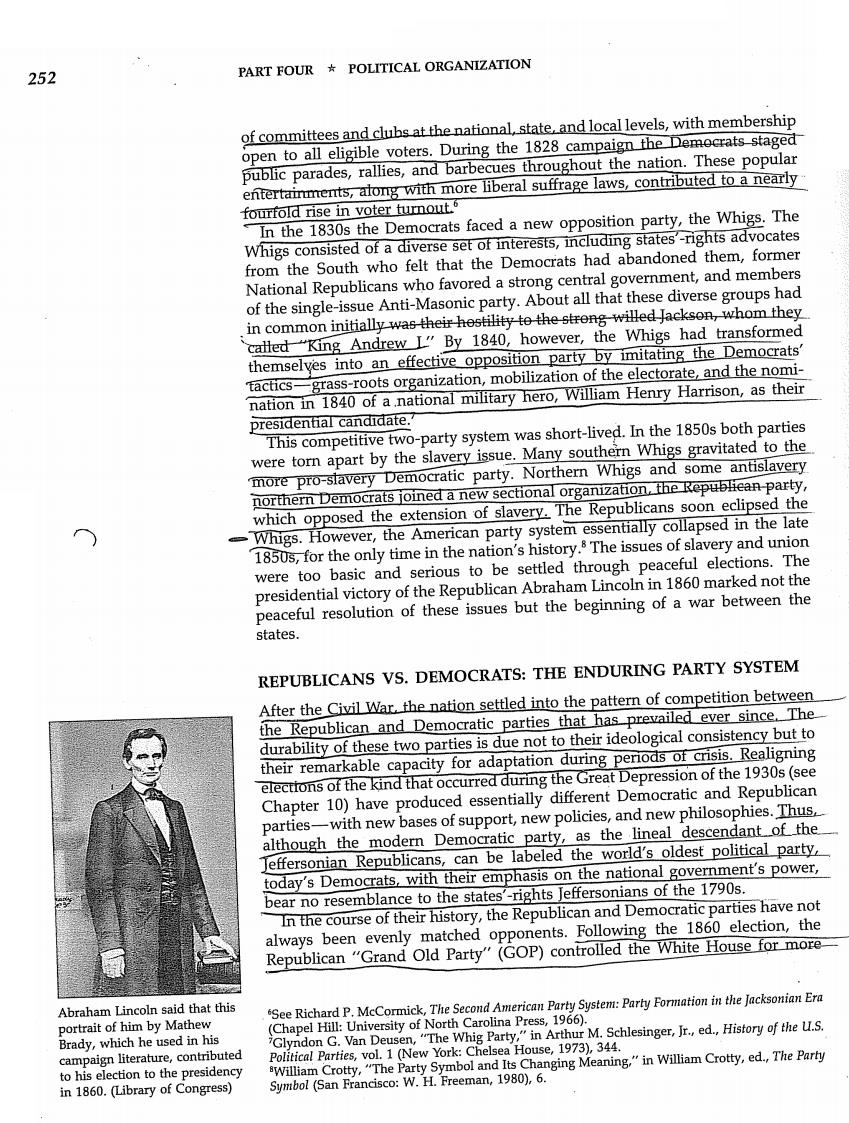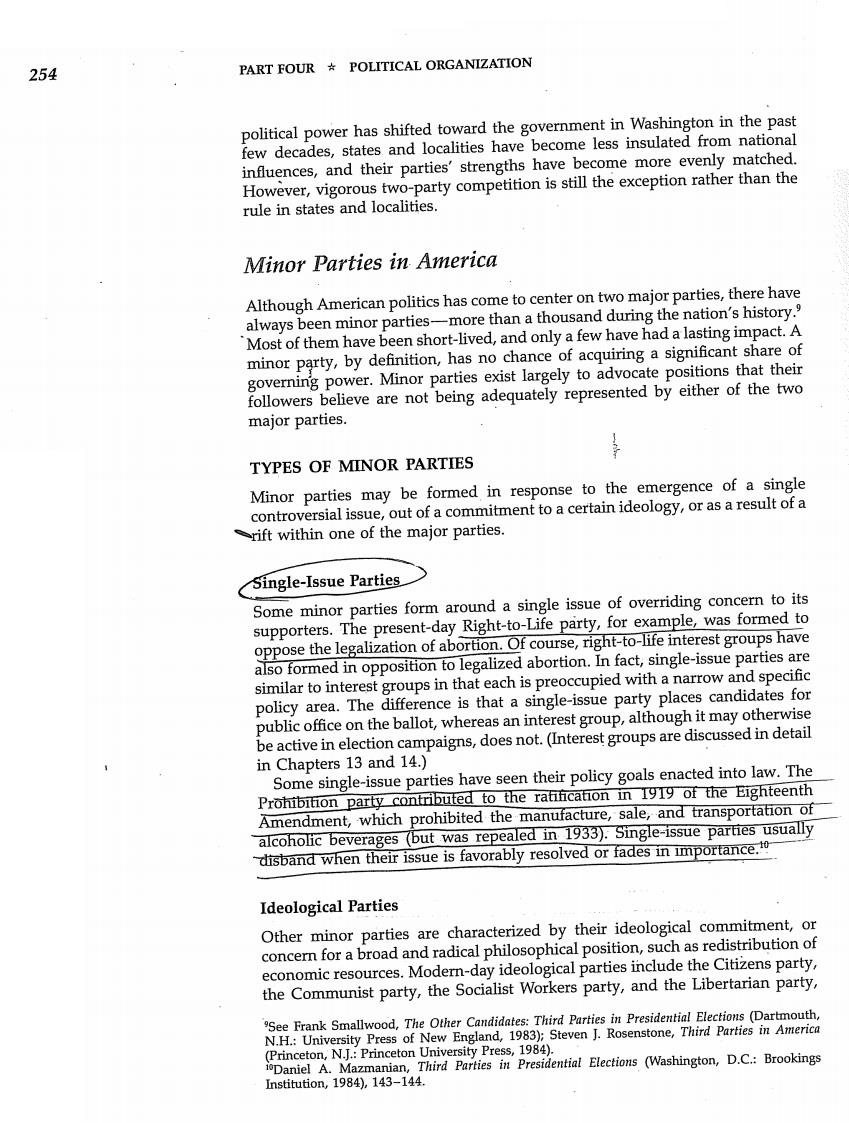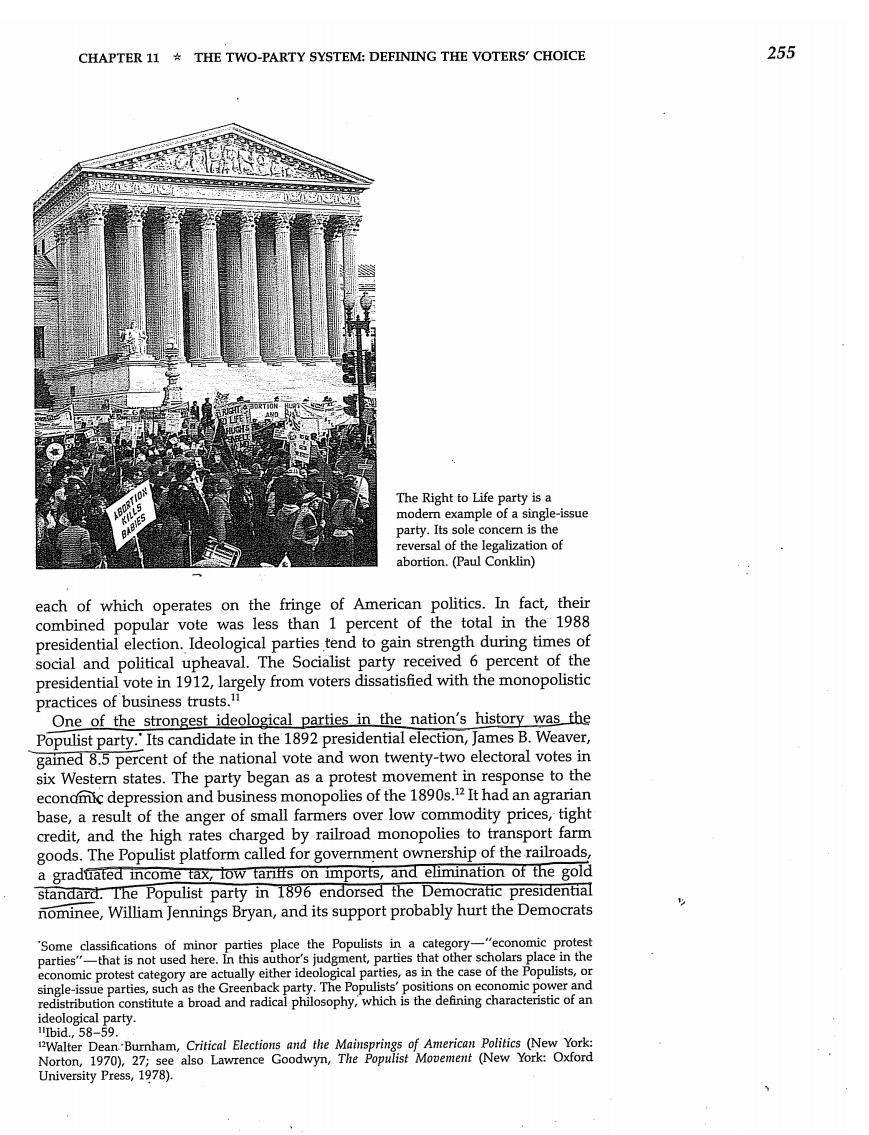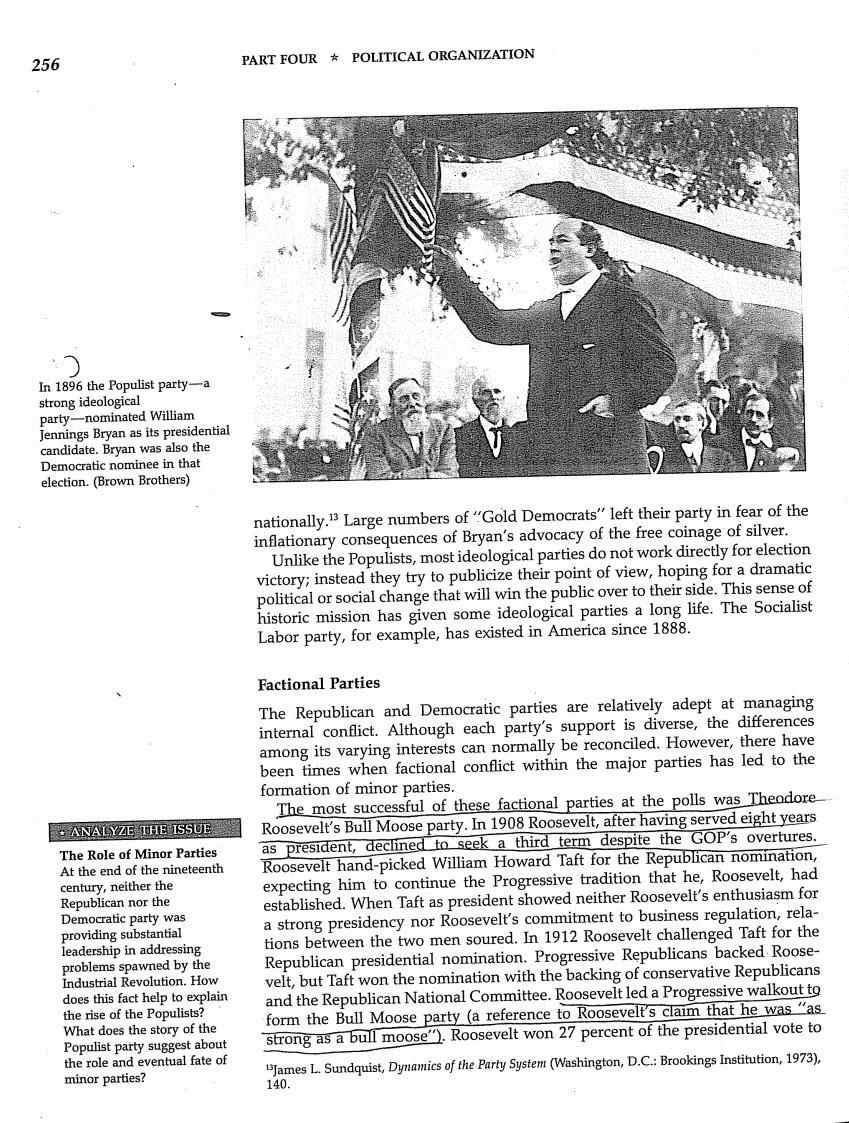
252 PART FOUR POLITICAL ORGANIZATION of committees and clubs at the national,state,and local levels,with membership open to all eligible voters.During the 1828 campaign the Demecrats staged public parades,rallies,and barbecues throughout the nation.These popular entertainments,along with more liberal suffrage laws,contributed to a nearly fourfold rise in voter turnout In the 1830s the Democrats faced a new opposition party,the Whigs.The Whigs consisted of a diverse set of interests,including states'-rights advocates from the South who felt that the Democrats had abandoned them,former National Republicans who favored a strong central government,and members of the single-issue Anti-Masonic party.About all that these diverse groups had in common initially was their hestility to the strong willed Jackson,whom they called "King Andrew L"'By 1840,however,the Whigs had transformed themselves into an effective opposition party by imitating the Democrats' tactics-grass-roots organization,mobilization of the electorate,and the nomi- nation in 1840 of a .national military hero,William Henry Harrison,as their presidential candidate.' This competitive two-party system was short-lived.In the 1850s both parties were torn apart by the slavery issue.Many southern Whigs gravitated to the more pro-slavery Democratic party.Northern Whigs and some antislavery northern Democrats joined a new sectional organization,the Republean party, which opposed the extension of slavery.The Republicans soon eclipsed the Whigs.However,the American party system essentially collapsed in the late 1850s,for the only time in the nation's history.The issues of slavery and union were too basic and serious to be settled through peaceful elections.The presidential victory of the Republican Abraham Lincoln in 1860 marked not the peaceful resolution of these issues but the beginning of a war between the states. REPUBLICANS VS.DEMOCRATS:THE ENDURING PARTY SYSTEM After the Civil War,the nation settled into the pattern of competition between the Republican and Democratic parties that has prevailed ever since.The durability of these two parties is due not to their ideological consistency but to their remarkable capacity for adaptation during periods of crisis.Realigning elections of the kind that occurred during the Great Depression of the 1930s(see Chapter 10)have produced essentially different Democratic and Republican parties-with new bases of support,new policies,and new philosophies.Thus. although the modern Democratic party,as the lineal descendant of the Jeffersonian Republicans,can be labeled the world's oldest political party, today's Democrats,with their emphasis on the national government's power, bear no resemblance to the states'-rights Jeffersonians of the 1790s. In the course of their history,the Republican and Democratic parties have not always been evenly matched opponents.Following the 1860 election,the Republican "Grand Old Party"(GOP)controlled the White House for more Abraham Lincoln said that this See Richard P.McCormick,The Second American Party System:Party Formation in the Jacksonian Era portrait of him by Mathew (Chapel Hill:University of North Carolina Press,1966). Brady,which he used in his Glyndon G.Van Deusen,"The Whig Party,"in Arthur M.Schlesinger,Jr.,ed.,History of the U.S. campaign literature,contributed Political Parties,vol.1(New York:Chelsea House,1973),344. to his election to the presidency William Crotty,"The Party Symbol and Its Changing Meaning,"in William Crotty,ed.,The Party in 1860.(Library of Congress) Symbol (San Francisco:W.H.Freeman,1980),6

CHAPTER 11 THE TWO-PARTY SYSTEM:DEFINING THE VOTERS'CHOICE 253 Moine N.H Wash. Montana N.D. Minn. Oregon Mich. Wyo lowa Nebraska Ohio nd Mo. Tenn. Okla. New Mexico 月a. Democrats control both houses FIGURE 11-2 Party Control of State Legislatures,1989 Republicans control both houses Intense party competition is not found in most states.Source: No party controls both houses Congressional Quarterly Weekly Report,November 12,1988,2893, Nonpartisan unicameral 3299-3300. than seventy years,losing it during this period to only two Democrats,Grover Cleveland and Woodrow Wilson,each of whom was assisted by dissension within Republican ranks.Cleveland won in 1884 when the GOP denied nomination to its own incumbent,Chester A.Arthur,and turned instead to James G.Blaine ("the Man from Maine),who,it appears,had the support neither of progressive Republicans nor of his own running mate,John A.Logan. In 1912 Wilson won when the Republicans were split by the Bull Moose party candidacy of Theodore Roosevelt.Without these internal problems,the Repub- licans might have held the presidency without interruption from the Civil War to the Depression. Franklin D.Roosevelt's election in 1932 began a twenty-year period of Democratic presidencies,but since the early 1950s the two parties have divided control of the White House.In 1960,1968,and 1976,the margin of victory for either party's presidential candidate was a slender 3 percent or less.As for the legislative branch,the Democrats have dominated Congress since 1930,losing control of both House and Senate only in 1947-1948 and 1953-1954,and of the Senate in 1980-1986. On the state and local levels,intense two-party competition is not the norm. In most states,for example,both houses of the legislature are controlled by the same party(see Figure 11-2).Party dominance tends to follow regional lines. Since the Civil War,Democrats have held sway over southern politics-the South's revenge on the party of Lincoln;only in recent decades has the region begun to see more party competition.The Republican party also has its traditional strongholds,such as New England and the rural Midwest,although Democratic candidates have recently improved their showing in these areas.As

254 PART FOUR POLITICAL ORGANIZATION political power has shifted toward the government in Washington in the past few decades,states and localities have become less insulated from national influences,and their parties'strengths have become more evenly matched. However,vigorous two-party competition is still the exception rather than the rule in states and localities. Minor Parties in America Although American politics has come to center on two major parties,there have always been minor parties-more than a thousand during the nation's history. Most of them have been short-lived,and only a few have had a lasting impact.A minor party,by definition,has no chance of acquiring a significant share of governing power.Minor parties exist largely to advocate positions that their followers believe are not being adequately represented by either of the two major parties. TYPES OF MINOR PARTIES Minor parties may be formed in response to the emergence of a single controversial issue,out of a commitment to a certain ideology,or as a result of a rift within one of the major parties. Single-Issue Parties Some minor parties form around a single issue of overriding concern to its supporters.The present-day Right-to-Life party,for example,was formed to oppose the legalization of abortion.Of course,right-to-life interest groups have also formed in opposition to legalized abortion.In fact,single-issue parties are similar to interest groups in that each is preoccupied with a narrow and specific policy area.The difference is that a single-issue party places candidates for public office on the ballot,whereas an interest group,although it may otherwise be active in election campaigns,does not.(Interest groups are discussed in detail in Chapters 13 and 14.) Some single-issue parties have seen their policy goals enacted into law.The Prohibition party contributed to the ratification in 1919 of the Eighteenth Amendment,which prohibited the manufacture,sale,and transportation of alcoholic beverages (but was repealed in 1933).Single-issue parties usually disband when their issue is favorably resolved or fades in importance. Ideological Parties Other minor parties are characterized by their ideological commitment,or concern for a broad and radical philosophical position,such as redistribution of economic resources.Modern-day ideological parties include the Citizens party, the Communist party,the Socialist Workers party,and the Libertarian party, See Frank Smallwood,The Other Candidates:Third Parties in Presidential Elections(Dartmouth, N.H.:University Press of New England,1983);Steven J.Rosenstone,Third Parties in America (Princeton,N.J.:Princeton University Press,1984). 1Daniel A.Mazmanian,Third Parties in Presidential Elections (Washington,D.C.:Brookings nstitution,1984),143-144

CHAPTER 11 THE TWO-PARTY SYSTEM:DEFINING THE VOTERS'CHOICE 255 The Right to Life party is a modern example of a single-issue party.Its sole concern is the reversal of the legalization of abortion.(Paul Conklin) each of which operates on the fringe of American politics.In fact,their combined popular vote was less than 1 percent of the total in the 1988 presidential election.Ideological parties tend to gain strength during times of social and political upheaval.The Socialist party received 6 percent of the presidential vote in 1912,largely from voters dissatisfied with the monopolistic practices of business trusts.11 One of the strongest ideological parties in the nation's history was the Populist party.'Its candidate in the 1892 presidential election,James B.Weaver, gained 8.5 percent of the national vote and won twenty-two electoral votes in six Western states.The party began as a protest movement in response to the econdmic depression and business monopolies of the 1890s.12 It had an agrarian base,a result of the anger of small farmers over low commodity prices,tight credit,and the high rates charged by railroad monopolies to transport farm goods.The Populist platform called for government ownership of the railroads, a graduated income tax,low tariffs on imports,and elimination of the gold standard.The Populist party in 1896 endorsed the Democratic presidential nominee,William Jennings Bryan,and its support probably hurt the Democrats 'Some classifications of minor parties place the Populists in a category-"economic protest parties"-that is not used here.In this author's judgment,parties that other scholars place in the economic protest category are actually either ideological parties,as in the case of the Populists,or single-issue parties,such as the Greenback party.The Populists'positions on economic power and redistribution constitute a broad and radical philosophy,which is the defining characteristic of an ideological party bid.,58-59. Walter Dean Burnham,Critical Elections and the Mainsprings of American Politics (New York: Norton,1970),27;see also Lawrence Goodwyn,The Populist Movement (New York:Oxford University Press,1978)

256 PART FOUR POLITICAL ORGANIZATION In 1896 the Populist party-a strong ideological party-nominated William Jennings Bryan as its presidential candidate.Bryan was also the Democratic nominee in that election.(Brown Brothers) nationally.1 Large numbers of"Gold Democrats"left their party in fear of the inflationary consequences of Bryan's advocacy of the free coinage of silver. Unlike the Populists,most ideological parties do not work directly for election victory;instead they try to publicize their point of view,hoping for a dramatic political or social change that will win the public over to their side.This sense of historic mission has given some ideological parties a long life.The Socialist Labor party,for example,has existed in America since 1888. Factional Parties The Republican and Democratic parties are relatively adept at managing internal conflict.Although each party's support is diverse,the differences among its varying interests can normally be reconciled.However,there have been times when factional conflict within the major parties has led to the formation of minor parties. The most successful of these factional parties at the polls was Theodore +AAYZ正ThE1SS0正 Roosevelt's Bull Moose party.In 1908 Roosevelt,after having served eight years The Role of Minor Parties as president,declined to seek a third term despite the GOP's overtures. At the end of the nineteenth Roosevelt hand-picked William Howard Taft for the Republican nomination, century,neither the expecting him to continue the Progressive tradition that he,Roosevelt,had Republican nor the established.When Taft as president showed neither Roosevelt's enthusiasm for Democratic party was a strong presidency nor Roosevelt's commitment to business regulation,rela- providing substantial leadership in addressing tions between the two men soured.In 1912 Roosevelt challenged Taft for the problems spawned by the Republican presidential nomination.Progressive Republicans backed Roose- Industrial Revolution.How velt,but Taft won the nomination with the backing of conservative Republicans does this fact help to explain and the Republican National Committee.Roosevelt led a Progressive walkout to the rise of the Populists? What does the story of the form the Bull Moose party(a reference to Roosevelt's claim that he was "as Populist party suggest about strong as a bull moose").Roosevelt won 27 percent of the presidential vote to the role and eventual fate of James L.Sundquist,Dynamics of the Party System(Washington,D.C.:Brookings Institution,1973), minor parties? 140